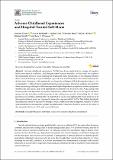Files in this item
Adverse childhood experiences and hospital-treated self-harm
Item metadata
| dc.contributor.author | Cleare, Seonaid | |
| dc.contributor.author | Wetherall, Karen | |
| dc.contributor.author | Clark, Andrea | |
| dc.contributor.author | Ryan, Caoimhe | |
| dc.contributor.author | Kirtley, Olivia | |
| dc.contributor.author | Smith, Michael | |
| dc.contributor.author | O’connor, Rory | |
| dc.date.accessioned | 2018-06-12T09:30:14Z | |
| dc.date.available | 2018-06-12T09:30:14Z | |
| dc.date.issued | 2018-06-11 | |
| dc.identifier | 253343736 | |
| dc.identifier | 534bd7fe-e7f3-4a64-81e9-10745a0222b1 | |
| dc.identifier | 85048598162 | |
| dc.identifier | 000436496900186 | |
| dc.identifier.citation | Cleare , S , Wetherall , K , Clark , A , Ryan , C , Kirtley , O , Smith , M & O’connor , R 2018 , ' Adverse childhood experiences and hospital-treated self-harm ' , International Journal of Environmental Research and Public Health , vol. 15 , no. 6 , 1235 . https://doi.org/10.3390/ijerph15061235 | en |
| dc.identifier.issn | 1660-4601 | |
| dc.identifier.other | crossref: 10.3390/ijerph15061235 | |
| dc.identifier.uri | https://hdl.handle.net/10023/13934 | |
| dc.description | The study was funded by NHS Greater Glasgow and ClydeMental Health and Sexual Health Partnerships and NHS Health Scotland. | en |
| dc.description.abstract | Adverse childhood experiences (ACEs) have been implicated in a range of negative health outcomes in adulthood, including increased suicide mortality. In this study, we explored the relationship between ACEs and hospital-treated self-harm. Specifically, we investigated whether those who had a history of repeat self-harm reported more ACEs than those who had self-harmed for the first time. Patients (n = 189) admitted to two hospitals in Glasgow (UK) following first-time (n = 41) or repeated (n = 148) self-harm completed psychosocial measures. Univariate analyses revealed that those presenting with repeat self-harm reported higher depressive symptoms, anxiety symptoms, intent to die, and ACEs, and lower dependent attachment style. However, only ACEs, along with female gender and depressive symptoms, significantly differentiated between the repeat self-harm group and the first-time self-harm group in the multivariate model. Controlling for all other psychosocial variables, participants who reported 4+ ACEs were significantly more likely to be in the repeat self-harm group as compared to those who experienced 0–3 ACEs. This finding highlights the pernicious effect of exposure to multiple ACEs. Further research is urgently required to better understand the mechanisms that explain this relationship. Clinicians should be aware of the extent of the association between ACEs and repeat self-harm. | |
| dc.format.extent | 13 | |
| dc.format.extent | 320853 | |
| dc.language.iso | eng | |
| dc.relation.ispartof | International Journal of Environmental Research and Public Health | en |
| dc.subject | Suicidal behaviour | en |
| dc.subject | Self-harm | en |
| dc.subject | Risk factors | en |
| dc.subject | Adverse childhood experiences | en |
| dc.subject | BF Psychology | en |
| dc.subject | RJ101 Child Health. Child health services | en |
| dc.subject | NDAS | en |
| dc.subject | SDG 3 - Good Health and Well-being | en |
| dc.subject.lcc | BF | en |
| dc.subject.lcc | RJ101 | en |
| dc.title | Adverse childhood experiences and hospital-treated self-harm | en |
| dc.type | Journal article | en |
| dc.contributor.institution | University of St Andrews. School of Psychology and Neuroscience | en |
| dc.identifier.doi | 10.3390/ijerph15061235 | |
| dc.description.status | Peer reviewed | en |
This item appears in the following Collection(s)
Items in the St Andrews Research Repository are protected by copyright, with all rights reserved, unless otherwise indicated.

